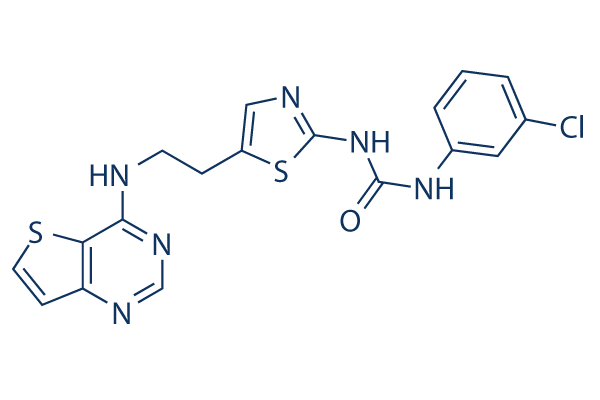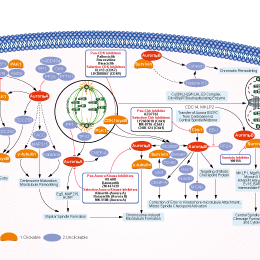
- Bioactive Compounds
- By Signaling Pathways
- PI3K/Akt/mTOR
- Epigenetics
- Methylation
- Immunology & Inflammation
- Protein Tyrosine Kinase
- Angiogenesis
- Apoptosis
- Autophagy
- ER stress & UPR
- JAK/STAT
- MAPK
- Cytoskeletal Signaling
- Cell Cycle
- TGF-beta/Smad
- Compound Libraries
- Popular Compound Libraries
- Customize Library
- Clinical and FDA-approved Related
- Bioactive Compound Libraries
- Inhibitor Related
- Natural Product Related
- Metabolism Related
- Cell Death Related
- By Signaling Pathway
- By Disease
- Anti-infection and Antiviral Related
- Neuronal and Immunology Related
- Fragment and Covalent Related
- FDA-approved Drug Library
- FDA-approved & Passed Phase I Drug Library
- Preclinical/Clinical Compound Library
- Bioactive Compound Library-I
- Bioactive Compound Library-Ⅱ
- Kinase Inhibitor Library
- Express-Pick Library
- Natural Product Library
- Human Endogenous Metabolite Compound Library
- Alkaloid Compound LibraryNew
- Angiogenesis Related compound Library
- Anti-Aging Compound Library
- Anti-alzheimer Disease Compound Library
- Antibiotics compound Library
- Anti-cancer Compound Library
- Anti-cancer Compound Library-Ⅱ
- Anti-cancer Metabolism Compound Library
- Anti-Cardiovascular Disease Compound Library
- Anti-diabetic Compound Library
- Anti-infection Compound Library
- Antioxidant Compound Library
- Anti-parasitic Compound Library
- Antiviral Compound Library
- Apoptosis Compound Library
- Autophagy Compound Library
- Calcium Channel Blocker LibraryNew
- Cambridge Cancer Compound Library
- Carbohydrate Metabolism Compound LibraryNew
- Cell Cycle compound library
- CNS-Penetrant Compound Library
- Covalent Inhibitor Library
- Cytokine Inhibitor LibraryNew
- Cytoskeletal Signaling Pathway Compound Library
- DNA Damage/DNA Repair compound Library
- Drug-like Compound Library
- Endoplasmic Reticulum Stress Compound Library
- Epigenetics Compound Library
- Exosome Secretion Related Compound LibraryNew
- FDA-approved Anticancer Drug LibraryNew
- Ferroptosis Compound Library
- Flavonoid Compound Library
- Fragment Library
- Glutamine Metabolism Compound Library
- Glycolysis Compound Library
- GPCR Compound Library
- Gut Microbial Metabolite Library
- HIF-1 Signaling Pathway Compound Library
- Highly Selective Inhibitor Library
- Histone modification compound library
- HTS Library for Drug Discovery
- Human Hormone Related Compound LibraryNew
- Human Transcription Factor Compound LibraryNew
- Immunology/Inflammation Compound Library
- Inhibitor Library
- Ion Channel Ligand Library
- JAK/STAT compound library
- Lipid Metabolism Compound LibraryNew
- Macrocyclic Compound Library
- MAPK Inhibitor Library
- Medicine Food Homology Compound Library
- Metabolism Compound Library
- Methylation Compound Library
- Mouse Metabolite Compound LibraryNew
- Natural Organic Compound Library
- Neuronal Signaling Compound Library
- NF-κB Signaling Compound Library
- Nucleoside Analogue Library
- Obesity Compound Library
- Oxidative Stress Compound LibraryNew
- Plant Extract Library
- Phenotypic Screening Library
- PI3K/Akt Inhibitor Library
- Protease Inhibitor Library
- Protein-protein Interaction Inhibitor Library
- Pyroptosis Compound Library
- Small Molecule Immuno-Oncology Compound Library
- Mitochondria-Targeted Compound LibraryNew
- Stem Cell Differentiation Compound LibraryNew
- Stem Cell Signaling Compound Library
- Natural Phenol Compound LibraryNew
- Natural Terpenoid Compound LibraryNew
- TGF-beta/Smad compound library
- Traditional Chinese Medicine Library
- Tyrosine Kinase Inhibitor Library
- Ubiquitination Compound Library
-
Cherry Picking
You can personalize your library with chemicals from within Selleck's inventory. Build the right library for your research endeavors by choosing from compounds in all of our available libraries.
Please contact us at [email protected] to customize your library.
You could select:
- Antibodies
- Bioreagents
- qPCR
- 2x SYBR Green qPCR Master Mix
- 2x SYBR Green qPCR Master Mix(Low ROX)
- 2x SYBR Green qPCR Master Mix(High ROX)
- Protein Assay
- Protein A/G Magnetic Beads for IP
- Anti-Flag magnetic beads
- Anti-Flag Affinity Gel
- Anti-Myc magnetic beads
- Anti-HA magnetic beads
- Poly FLAG Peptide lyophilized powder
- Protease Inhibitor Cocktail
- Protease Inhibitor Cocktail (EDTA-Free, 100X in DMSO)
- Phosphatase Inhibitor Cocktail (2 Tubes, 100X)
- Cell Biology
- Cell Counting Kit-8 (CCK-8)
- Animal Experiment
- Mouse Direct PCR Kit (For Genotyping)
- New Products
- Contact Us
SNS-314
SNS-314 is a potent and selective inhibitor of Aurora A, Aurora B and Aurora C with IC50 of 9 nM, 31 nM, and 3 nM, respectively. It is less potent to Trk A/B, Flt4, Fms, Axl, c-Raf and DDR2. Phase 1.

SNS-314 Chemical Structure
CAS: 1057249-41-8
Selleck's SNS-314 has been cited by 11 Publications
3 Customer Reviews
Purity & Quality Control
Batch:
Purity:
99.07%
99.07
SNS-314 Related Products
| Related Targets | Aurora A Aurora B Aurora C Aurora B | Click to Expand |
|---|---|---|
| Related Products | Alisertib (MLN8237) Barasertib (AZD1152-HQPA) Tozasertib (VX-680) ZM 447439 MLN8054 Hesperadin Danusertib (PHA-739358) MK-5108 TCS7010 (Aurora A Inhibitor I) AMG-900 PHA-680632 CCT137690 GSK1070916 CYC116 TAK-901 CCT129202 SNS-314 Mesylate LY3295668 SP-96 | Click to Expand |
| Related Compound Libraries | Kinase Inhibitor Library PI3K/Akt Inhibitor Library MAPK Inhibitor Library DNA Damage/DNA Repair compound Library Cell Cycle compound library | Click to Expand |
Signaling Pathway
Choose Selective Aurora Kinase Inhibitors
Biological Activity
| Description | SNS-314 is a potent and selective inhibitor of Aurora A, Aurora B and Aurora C with IC50 of 9 nM, 31 nM, and 3 nM, respectively. It is less potent to Trk A/B, Flt4, Fms, Axl, c-Raf and DDR2. Phase 1. | ||||||
|---|---|---|---|---|---|---|---|
| Targets |
|
| In vitro | ||||
| In vitro | In HCT116 colorectal carcinoma cell line, with intact or depleted p53 protein levels, SNS-314 Mesylate shows enhanced efficacy when administered sequentially with other standard chemotherapeutic agents and the most profound synergies are identified for agents that activate the spindle assembly checkpoint, e.g., docetaxel and vincristine. [2] A recent study shows that SNS-314 Mesylate shows potent antiproliferative activity in HCT116 cells and inhibits soft agar colony formation. [3] | |||
|---|---|---|---|---|
| Kinase Assay | Aurora-A Kinase Assay | |||
| Humanized mouse Aurora A (amino acids 107-403) is expressed in E. coli as described previously. For IC50 assays, compounds are titrated three-fold in DMSO and diluted 12.5-fold into assay buffer (10 mM Tris HCl pH 7.2, 10 mM MgCl2, 0.05% NaN3, 0.01% Tween-20, and 0.1% BSA). Compounds are then diluted 4-fold into assay buffer containing Aurora A and FAM-PKAtide at final concentrations of 2 nM and 50 nM, respectively. The kinase reaction is initiated by adding ATP in assay buffer at a final concentration of 10 mM and incubated at 21 °C for 25 minutes. As a positive control, DMSO is added instead of compound and as a negative control assay buffer is added instead of Aurora A. Both control reactions are conducted in triplicate. To detect phosphorylated PKAtide, the kinase reaction is combined with Progressive Binding Solution (1:400 Progressive Binding Reagent, 1 × Buffer A, Molecular Devices) in a 1:3 ratio. The mixture is incubated for 30 minutes at 21 °C and the plate is scanned on an Analyst AD with excitation at 485 nm and emission at 530 nm. The percent relative enzymatic activity is calculated by normalizing the mP value for each well to the average positive control. Relative enzymatic activity values are plotted as a function of the logarithm of compound concentration and IC50 values are generated in GraphPad Prism software using a sigmoidal dose-response curve-fit. IC50 | ||||
| Cell Research | Cell lines | HCT116 SCR and HCT116 p53 RNAi cells | ||
| Concentrations | ~125 nM | |||
| Incubation Time | 48 hours | |||
| Method | Viability is measured using the CellTiter-Blue cell viability assay. Cells are treated as described above, although with a 5-day incubation period. Cytotoxicity is determined by measuring intracellular ATP using the CellTiter-Glo Luminescence Cell Viability Assay. Cells are seeded in white 96-well tissue culture plates at a density of 1.5-2 × 103 cells/well, and a serial dilution of SNS-314 is dosed in combination with fixed concentrations of either docetaxel or vincristine for a total of 72 hours. Viability is determined as the ratio between the ATP in treated cells versus control cells. Apoptosis is measured using the caspase-Glo 3/7 system. Cells are plated in white 96-well plates as described above and treated first with SNS-314 for 24 hours, washed with 200 μL of 1× PBS, and fresh medium is added with the second agent for 24 hours. |
|||
| In Vivo | ||
| In vivo | The sequential treatment with SNS-314 Mesylate followed by docetaxel 24 hours later produces a significant 72.5% tumor growth inhibition of HCT116 xenografts, while docetaxel and SNS-314 Mesylate as single agents produce no significant inhibition of HCT116 tumor growth. [2] In the HCT116 human colon cancer xenograft model, administration of 50 and 100 mg/kg SNS-314 Mesylate results a dose-dependent inhibition of histone H3 phosphorylation, indicating effective Aurora-B inhibition in vivo. In addition, HCT116 tumors from animals treated with SNS-314 Mesylate exhibits potent and sustained responses including reduction of phosphorylated histone H3 levels, increased caspase-3 and appearance of increased nuclear size. [3] | |
|---|---|---|
| Animal Research | Animal Models | HCT116 cells are injected s.c. into the right flank of nu/nu mice. |
| Dosages | ≤42.5 mg/kg | |
| Administration | Administered via i.p. | |
| NCT Number | Recruitment | Conditions | Sponsor/Collaborators | Start Date | Phases |
|---|---|---|---|---|---|
| NCT00519662 | Completed | Advanced Solid Tumors |
Sunesis Pharmaceuticals |
August 2007 | Phase 1 |
Chemical Information & Solubility
| Molecular Weight | 430.93 | Formula | C18H15ClN6OS2 |
| CAS No. | 1057249-41-8 | SDF | Download SNS-314 SDF |
| Smiles | C1=CC(=CC(=C1)Cl)NC(=O)NC2=NC=C(S2)CCNC3=NC=NC4=C3SC=C4 | ||
| Storage (From the date of receipt) | |||
|
In vitro |
DMSO : 100 mg/mL ( (232.05 mM); Moisture-absorbing DMSO reduces solubility. Please use fresh DMSO.) Water : Insoluble Ethanol : Insoluble |
Molecular Weight Calculator |
|
In vivo Add solvents to the product individually and in order. |
In vivo Formulation Calculator |
||||
Preparing Stock Solutions
Molarity Calculator
In vivo Formulation Calculator (Clear solution)
Step 1: Enter information below (Recommended: An additional animal making an allowance for loss during the experiment)
mg/kg
g
μL
Step 2: Enter the in vivo formulation (This is only the calculator, not formulation. Please contact us first if there is no in vivo formulation at the solubility Section.)
% DMSO
%
% Tween 80
% ddH2O
%DMSO
%
Calculation results:
Working concentration: mg/ml;
Method for preparing DMSO master liquid: mg drug pre-dissolved in μL DMSO ( Master liquid concentration mg/mL, Please contact us first if the concentration exceeds the DMSO solubility of the batch of drug. )
Method for preparing in vivo formulation: Take μL DMSO master liquid, next addμL PEG300, mix and clarify, next addμL Tween 80, mix and clarify, next add μL ddH2O, mix and clarify.
Method for preparing in vivo formulation: Take μL DMSO master liquid, next add μL Corn oil, mix and clarify.
Note: 1. Please make sure the liquid is clear before adding the next solvent.
2. Be sure to add the solvent(s) in order. You must ensure that the solution obtained, in the previous addition, is a clear solution before proceeding to add the next solvent. Physical methods such
as vortex, ultrasound or hot water bath can be used to aid dissolving.
Tech Support
Answers to questions you may have can be found in the inhibitor handling instructions. Topics include how to prepare stock solutions, how to store inhibitors, and issues that need special attention for cell-based assays and animal experiments.
Tel: +1-832-582-8158 Ext:3
If you have any other enquiries, please leave a message.
* Indicates a Required Field
Tags: buy SNS-314 | SNS-314 supplier | purchase SNS-314 | SNS-314 cost | SNS-314 manufacturer | order SNS-314 | SNS-314 distributor








































